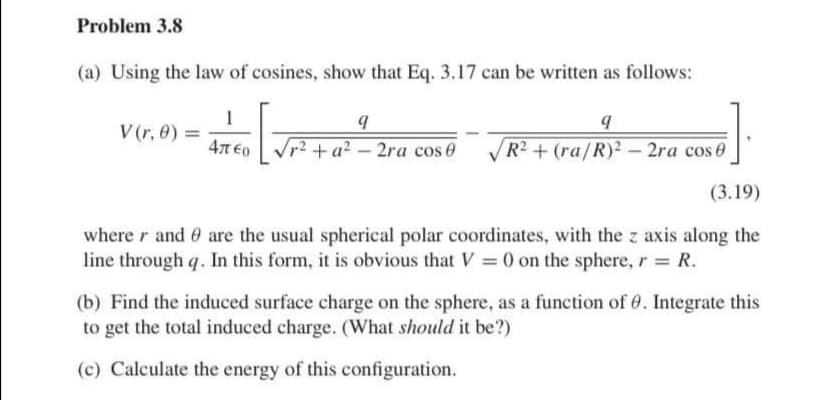(a) Using the law of cosines, show that Eq. 3.17 can be written as follows: V(r, 0) = 9 4лEо √²+ a²- 2ra cos ²+a². 0 9 R² + (ra/R)²-2ra cos (3.19) where r and are the usual spherical polar coordinates, with the z axis along the line through q. In this form, it is obvious that V = 0 on the sphere, r = R. (b) Find the induced surface charge on the sphere, as a function of 0. Integrate this to get the total induced charge. (What should it be?) (c) Calculate the energy of this configuration.
(a) Using the law of cosines, show that Eq. 3.17 can be written as follows: V(r, 0) = 9 4лEо √²+ a²- 2ra cos ²+a². 0 9 R² + (ra/R)²-2ra cos (3.19) where r and are the usual spherical polar coordinates, with the z axis along the line through q. In this form, it is obvious that V = 0 on the sphere, r = R. (b) Find the induced surface charge on the sphere, as a function of 0. Integrate this to get the total induced charge. (What should it be?) (c) Calculate the energy of this configuration.
Related questions
Question
100%
Subject : Electromagnetism

Transcribed Image Text:Problem 3.8
(a) Using the law of cosines, show that Eq. 3.17 can be written as follows:
1
4π€o
V(r, 0) =
9
r²+ a²-2ra cos 0
9
R2 + (ra/R)2- 2ra cos 0
(3.19)
where r and are the usual spherical polar coordinates, with the z axis along the
line through q. In this form, it is obvious that V = 0 on the sphere, r = R.
(b) Find the induced surface charge on the sphere, as a function of 0. Integrate this
to get the total induced charge. (What should it be?)
(c) Calculate the energy of this configuration.
Expert Solution
This question has been solved!
Explore an expertly crafted, step-by-step solution for a thorough understanding of key concepts.
This is a popular solution!
Trending now
This is a popular solution!
Step by step
Solved in 7 steps
